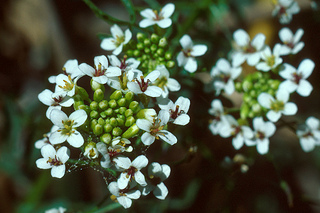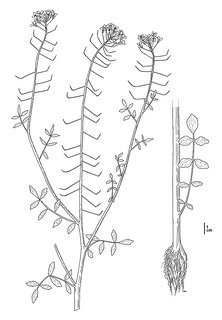(Nasturtium gambelii)
 Nasturtium gambelii. Photo © California Native Plant Society 1984.
Nasturtium gambelii. Photo © California Native Plant Society 1984.
 Nasturtium gambelii. CDFW illustration by Mary Ann Showers. (Click to enlarge)
Nasturtium gambelii. CDFW illustration by Mary Ann Showers. (Click to enlarge)
Gambel’s water cress is a California threatened plant species, which means that killing or possessing this plant is prohibited by the California Endangered Species Act (CESA). This species is also listed as endangered under the federal Endangered Species Act. Gambel’s water cress is a perennial herb in the mustard family (Brassicaceae) that can grow to six feet tall. It produces dense heads of white flowers that generally bloom from April to July, but may bloom through August and into October. Historically, Gambel’s water cress occurred in interior wetland areas of San Diego, San Bernardino, and Los Angeles counties as well as coastal wetland areas of San Luis Obispo and Santa Barbara counties. It has also been collected from the Valley of Mexico, but this population is presumed to be extirpated. At the time of state listing in 1990, this species was only known from three populations, all located in San Luis Obispo County. Since the time of listing an additional population was discovered at Vandenberg Air Force Base in Santa Barbara County. Gambel’s water cress hybridizes with common water cress (Nasturtium officinale), and the U.S. Fish and Wildlife Service 5-Year Review (2011) for this species indicates that recent surveys have not identified any pure Gambel’s water cress plants at the three San Luis Obispo County populations. All plants observed are either introgressed with common water cress, meaning they contain genetic material from this species, or only common water cress exists at the site. The population at Vandenberg Air Force Base is the only remaining wild population supporting pure Gambel’s water cress, although there is a possibility that hybrid individuals may also occur at this population. This species was introduced to a site on the Guadalupe-Nipomo Dunes National Wildlife Refuge in San Luis Obispo County in October 2008, but at the time of the 5-year review, the U.S. Fish and Wildlife Service did not consider the plants at this location to be fully established and did not consider this a viable population.
At the time of state listing, the primary threat to Gambel’s water cress was the loss of suitable wetland habitat. Habitat loss persists as a threat, and other threats include alteration of the hydrological regime, degradation of habitat due to development and urbanization, and hybridization with the widespread and invasive common water cress. In addition, excessive amounts of nitrogen and other nutrients in the water can lead to conversion of habitat caused by excessive growth of species such as cattails, bulrush, and willows, thus causing a decline in the quantity and quality of habitat for Gambel’s water cress. Since only one known wild population of Gambel’s water cress exists, this species is also highly vulnerable to extinction from random natural events.
The population of Gambel’s water cress at Vandenberg Air Force Base should be managed in cooperation with the U.S. Air Force in the immediate future to alleviate threats and to prevent the loss of the last known remaining wild population. Although CDFW participated in a study of Arenaria paludicola (marsh sandwort) and Gambel’s watercress in Black Lake Canyon and the Oso Flaco Lake Region that involved field observations, greenhouse cultivation, molecular genetic variation, and trial reintroductions (PDF) through participation in the Cooperative Endangered Species Conservation Fund, additional efforts should be undertaken to establish new populations within the species’ historical range. Nutrient levels in the watersheds that supported Gambel’s water cress in the recent past should be researched to determine the potential causes for loss of this species at these sites, and water quality threats should be alleviated in these areas in coordination with local landowners and stakeholders. In addition, genetic analyses should be continued to determine the variation within and between populations, and also to identify the magnitude of the threat of gene swamping from common water cress. Results from these analyses should be used to help determine an appropriate recovery and reintroduction strategy.
CDFW may issue permits for Gambel’s water cress pursuant to CESA, and you can learn more about the California laws protecting Gambel’s water cress and other California native plants. The remaining wild population of Gambel’s water cress occurs in CDFW’s South Coast Region. More information is also available from the U.S. Fish and Wildlife Service Species Profile forGambel’s Water Cress.
Updated 01/14/2014